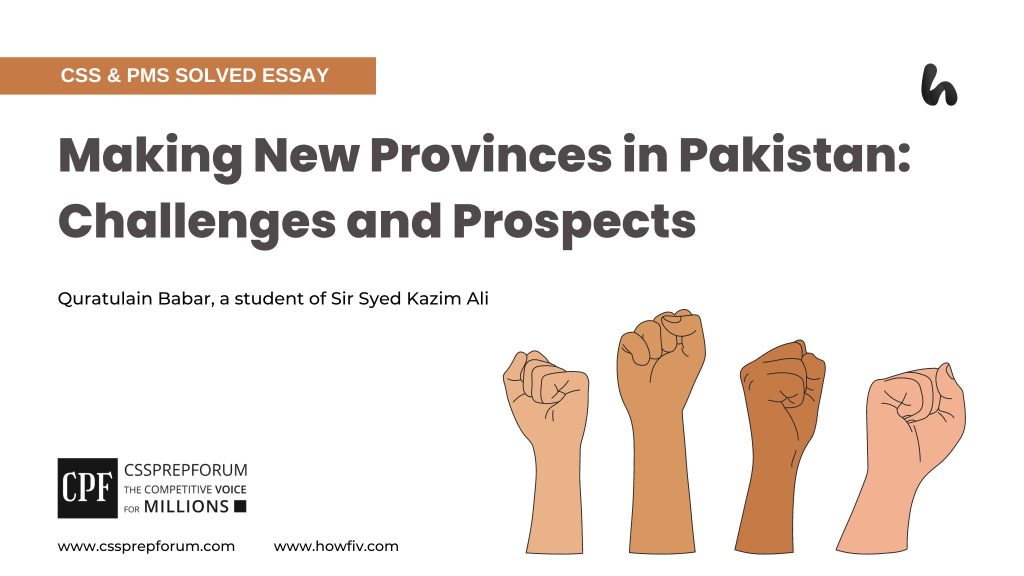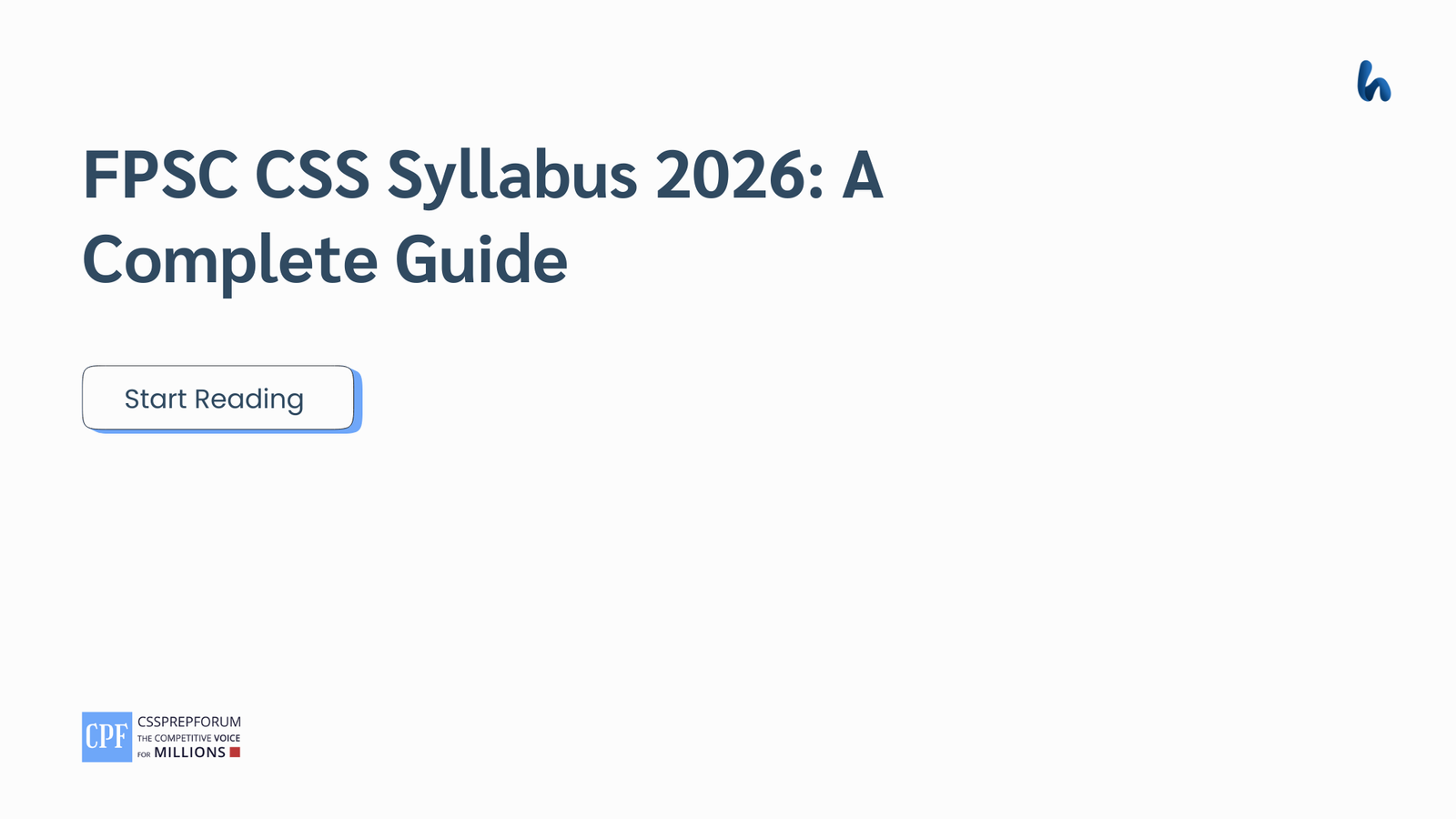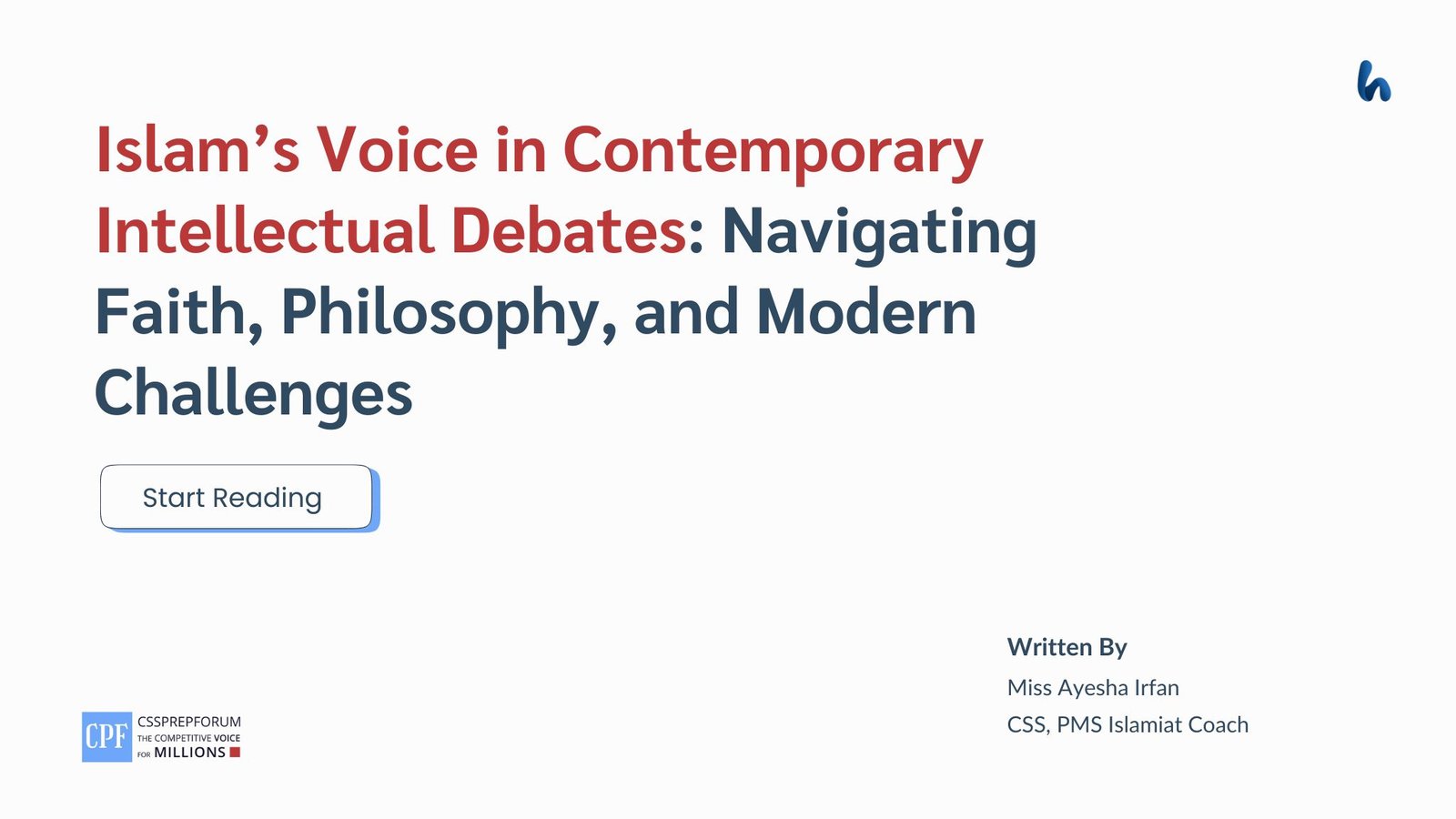CSS & PMS Solved Essays | Making New Provinces in Pakistan: Challenges and Prospects
Quratulain Babar, a Sir Syed Kazim Ali student, has attempted the CSS & PMS essay “Making New Provinces in Pakistan: Challenges and Prospects” on the given pattern, which Sir Syed Kazim Ali teaches his students. Sir Syed Kazim Ali has been Pakistan’s top English writing and CSS, PMS essay and precis coach with the highest success rate of his students. The essay is uploaded to help other competitive aspirants learn and practice essay writing techniques and patterns to qualify for the essay paper.

Outline
1-Introduction
The creation of new provinces in Pakistan is a complex issue with various challenges, but overcoming these obstacles through a collaborative effort from all stakeholders can lead to national integration, economic development, and a well-governed federation, which are essential for the country’s socio-economic growth and progress.
2-Why more provinces are essential?
3-Demand of new provinces in Pakistan
4-Challenges in the way of the making of new provinces in Pakistan
- ✓Complex Constitutional Procedures
- Evidence: Article 237 requires the consent of a two-thirds majority of the Houses of Parliament to form new provinces.
- ✓Major Political Parties
- Evidence: The division of Sindh into more provinces would result in Pakistan’s Peoples Party (PPP) losing its vote bank.
- ✓Ethnic and Linguistic Movements
- Evidence: Seraiki intellectuals and nationalists believe that creating a province without the word Seraiki would be not only incomplete but also meaningless.
- ✓Forces of Centralization
- Evidence: These forces do not favour a decentralized system in the country because doing so would shift the economic and political powers to the lower levels.
- ✓Economic Implications
- Evidence: If new provinces are created, there would be a significant increase in the non-development expenditure.
5-Prospects of new provinces in Pakistan
- ✓Building of a strong Federation
- Evidence: Air Martial Asghar Khan once said that making four provinces twelve would bring the benefits the Indian government had achieved by dividing East Punjab; otherwise, the Bhandrawala Movement would have drowned India.
- ✓Economic Development
- Evidence: South Punjab may have large cotton textile units, and KPK may advance hydropower plans with its water resources, eventually leading to the economic development of their marginalized regions.
- ✓Better Governance
- Evidence: Pakistan can learn from France, which has improved its governance by forming new provinces.
- ✓National Integration
- Evidence: National cohesion would increase in Pakistan, as in Switzerland, which has increased its administrative units.
- ✓A Healthy and Responsible Society
- Evidence: Like Canada, the living conditions of Pakistanis would also improve, fostering its societal well-being.
6-Suggestions to remove the impediments in the making of new provinces in Pakistan
- ✓Changes in the Constitution
- ✓Formation of a national commission
7-Conclusion

The division of a country into smaller provinces, constituent units, regions, and states is crucial for a nation’s smooth and uninterrupted socio-economic development. Many countries have formed new units to meet their people’s growing demands and advance their administrative structure. For instance, Austria, with a population of 8.8 million and almost equal to the size of Khyber Pakhtunkhwa, has nine provinces and a GDP per capita income of $50000. In contrast, with a population of 231.4 million, Pakistan has only four provinces, impeding the country’s socio-economic growth. In fact, creating new provinces in Pakistan is a complex and multifaceted issue involving political, economic, cultural, and administrative considerations. Several constitutional impediments, vested interests of political parties, and economic implications of the new provinces pose challenges to their formation. Nevertheless, creating new provinces would promote socio-economic and political development in the country. It would lead to the economic development of underdeveloped areas, national integration, and a robust and well-governed federation, which are crucial for the country’s progress. Overcoming the obstacles to forming new provinces requires serious consideration of the issue and initiatives to counter the impediments. A collaborative effort from all stakeholders, including the government, political parties, and civil society, is imperative to successfully forming new provinces.
Before discussing the issue of new provinces in Pakistan, it is pertinent to comprehend the purpose and importance of new administrative units. These are very necessary to run the administrative affairs of a state. For this purpose, the state is divided into different administrative units like provinces, divisions, tehsils, and union councils. This division is vital for better administration and good governance in a country. In this system, power is decentralized from higher to lower levels, and the government works for the welfare of the people through this system. Over a few decades, many countries around the globe have increased their administrative units; for example, the number of provinces in Nigeria has increased from 4 to 17. Thus, these administrative units are the tools of good governance and administration.
Regarding Pakistan, compelling reasons warrant the formation of new provinces. For instance, the backward regions have grievances regarding the widening gap between developed and underdeveloped areas. This is manifested in an imbalance in power-sharing, the backwardness of the marginalized, inequitable distribution of natural resources, discrimination in education and health facilities, and poverty issues. To illustrate, it is evident from Pakistan’s economic surveys that the poverty trend in South Punjab has been high compared to North and Central Punjab. It refers to the growing socio-economic inequalities prevalent in the country.
Nonetheless, there are many challenges to forming new provinces in the country. For example, the constitutional impediment is the primary factor derailing the creation of new administrative units. Under the current constitutional arrangements, forming new provinces is not easy because it is challenging to change the boundaries of the existing provinces. To illustrate, under Article 237 of the constitution, the constitutional procedure for forming new provinces requires an amendment bill to be formed in both Houses of Parliament, which a two-thirds majority of both Houses must approve. In addition, the assent of the Provincial Assembly is also essential to change the boundaries of the concerned province. Thus, these constitutional requirements complicate the process of making new provinces, especially in coalition government.
Moreover, major political parties pose another hindrance to the formation of new provinces. Undoubtedly, they exploit aggrieved peoples’ issues for their political point scoring and increase their vote bank by supporting the cause of new provinces. But after taking the political advantage, they forget the problem. Further, political parties lack the political will to form new provinces as it affects their political base. To illustrate, dividing Sindh into more provinces would result in Pakistan’s Peoples Party (PPP) losing its vote bank. And the same is the case with the Pakistan Muslim League – Nawaz (PML – N), which has its stronghold in Punjab. Thus, this indicates that the vested interests of political parties have always impeded the formation of new provinces.
Like other challenges, ethnic and linguistic movements are a big hurdle in the way of making new provinces in the country. To elaborate, each province has a substantial geographically concentrated minority: Seraiki in South Punjab, Muhajirs in Sindh, Hazarewals in the Hazara region of Khyber Pakhtunkhwa, and Pashtuns in Baluchistan. All the movements for smaller units in these regions are working for the formation of new provinces on cultural, linguistic, and ethnic basis. For instance, Seraiki intellectuals and nationalists believe that creating a province without the word ‘Seraiki’ would be not only incomplete but also meaningless. This means that creation of new provinces on an ethnolinguistic basis would put the country’s existence at risk by giving rise to sub-nationalism. Thus, these movements themselves are a big challenge for forming new provinces in Pakistan.
Another element that stands in the way of forming new provinces in Pakistan is the force of centralization. Compared to modern-day federations, Pakistan’s federation is relatively centralized. The centralized forces still want to make the country a unitary or central state. These forces do not favour a decentralized system in the country because doing so would shift the economic and political powers to the lower levels. And the formation of new provinces is also a link in the same chain that demands devolution of power from the federal to the provincial level. So, the forces of centralization seriously threaten the formation of Pakistan’s new provinces.
Lastly, the economic implications of new provinces are also obstructing their creation. To illustrate, if new provinces are created in Pakistan, there would be a significant increase in the non-development expenditure in the country. This would put an additional burden on the country’s treasury. The stakeholders of Pakistan’s four main provinces are already eyeballing each other on dividing the funds in the NFC Awards and claiming it is a biased decision of the state runners. Unfortunately, given the already weak economic conditions the country faces, the economic implications of new provinces are also not negligible, hindering the formation of the country’s new provinces.
However, forming new provinces in Pakistan would yield numerous prospects for the country. First, new administrative units would strengthen the federation of the country. To illustrate, it is well-established that the smaller the provinces, the stronger the federation. Smaller units cannot muster resistance against the state. In this way, the nationalist forces can be prevented from emerging. Taking this into consideration, Air Martial Asghar Khan once said that making four provinces twelve would bring the benefits the Indian government had achieved by dividing East Punjab; otherwise, the Bhandrawala Movement would have drowned India. This may thus lead to a more robust Pakistan’s federation with a firm grip on its administrative units.
Second, the creation of smaller new provinces may result in the economic development of the underdeveloped and backward regions of the country. These new provincial units would have their financial plans and be able to mobilize additional funds for the backward zones that have been unprivileged of their due share. This would result in the emergence of new economic zones in the country. For instance, South Punjab may have large cotton textile units, and KPK may advance hydropower plans with its water resources, eventually leading to the economic development of their marginalized regions. In addition, the deprived areas would get a larger share of resources from the national exchequer. To illustrate, instead of spending much money on Lahore alone, some of it would be allocated to Dera Gazi Khan, Bhakkar, Bahawalpur, and adjoining areas. Hence, more new provinces would uplift the country’s underdeveloped regions economically.
Third, new provinces would help the government mitigate the governance issues. In fact, they would help address the grievances of the people living in backward areas. Undeniably, these new provinces’ governments would be more effective in delivering the downtrodden regions’ essential services, such as health, education, and sanitation, which the larger provincial governments do not deliver efficiently. And France is an excellent example in this regard. With a population of 67.8 million, it has 22 provinces that strengthen its administration and empower the citizenry. This devolution of power has improved the economic well-being of its people; for example, France’s GDP per capita is $44,100. It signifies that more provinces may foster a closer connection between the government and the masses, leading to socio-economic growth. Therefore, new provinces in Pakistan would enable the country to improve its administration.
Fourth, new provinces would promote national cohesion in the country. By providing services and making comprehensive economic policies in Pakistan, these units would develop a sense of political and economic inclusiveness in the country’s marginalized peoples’ minds. Ultimately, this would reduce the chances of the anti-state elements from the country penetrating the areas and exploiting the deprived masses. To illustrate, Switzerland is known for its federal structure, with 26 cantons (provinces), each having a high degree of autonomy. The country has maintained strong national cohesion through a system where the power is highly decentralized to the lower levels and ethnic and cultural diversities are respected. In the same way, new provinces in Pakistan can thus strengthen its national integration.
Last but not least, smaller new provinces in Pakistan may promote the growth of a healthy society with a responsible citizenry. To illustrate, improved deliverance of education would produce a well-informed citizenry. This would eventually positively affect the society in terms of health and political awareness. In addition, the economic development of the backward regions would provide job opportunities to the masses living there, thus reducing poverty. For example, statistics show that the economic conditions of the people of Canada have improved drastically, with only 9.4% of its population living below the poverty line. And one of the significant factors behind their improved living conditions is the formation of new provinces. No less significantly, the crime rate may also reduce as there would be more employment opportunities in the country. Thus, new provinces in the country would encourage the growth of Pakistani society.
All the prospects above testify to the importance of new provinces in Pakistan, and for this purpose, there is a need to avert the challenges to their formation. This can be done by taking specific bold steps. For instance, there is a need to amend the existing constitutional procedures that complicate the creation of new provinces. To illustrate, sub-section four of Article 239 should be amended to change the resolution’s approval condition for new provinces by a two-thirds majority. Moreover, Article 1 of the constitution, which identifies four federal units, needs to be amended. Thus, these changes in the constitution help make the formation of provinces easier in Pakistan.
In addition, a national commission should be formed to form new provinces in Pakistan. For this purpose, the constitution should require a constitutional commission every ten to twenty years to investigate the need for new provinces. Besides this, the government should take the issue so that past disputes over the problem do not arise. In this regard, the reasons behind forming new provinces should be considered. These reasons should neither be political nor ethno-linguistic. Instead, providing timely services to the citizens should thus be the driving force behind creating new administrative units.
In a nutshell, the formation of new provinces in Pakistan presents significant challenges, including complex constitutional procedures, lack of political will, centralized forces, and economic implications. However, once established, new provinces in Pakistan can enhance governance, promote balanced economic development, and improve societal well-being. And to achieve these prospects requires pragmatic measures, such as amending relevant constitutional provisions and establishing a national commission to guide the process. Therefore, with coordinated efforts from the government, political parties, and civil society, the creation of new provinces can become a vital step toward a more equitable, well-governed, and progressive Pakistan.

CSS Solved Past Papers’ Essays
Looking for the last ten years of CSS and PMS Solved Essays and want to know how Sir Kazim’s students write and score the highest marks in the essays’ papers? Then, click on the CSS Solved Essays to start reading them.
CSS Solved Essays
CSS Solved General Science & Ability Past Papers
Want to read the last ten years’ General Science & Ability Solved Past Papers to learn how to attempt them and to score high? Let’s click on the link below to read them all freely. All past papers have been solved by Miss Iqra Ali & Dr Nishat Baloch, Pakistan’s top CSS GSA coach having the highest score of their students. General Science & Ability Solved Past Papers












